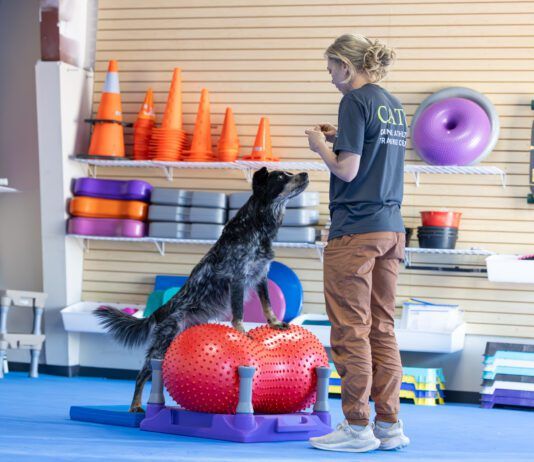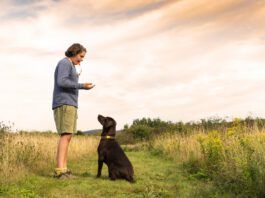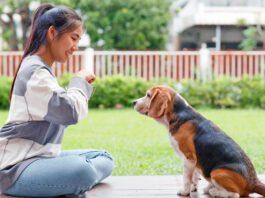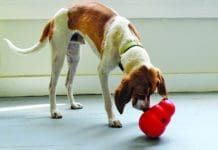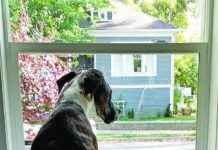The Best Food Dispensing Dog Toys
We still love the basic Kong toy, as well as the variety of other toys made by Kong. But we have to admit, we also love many of Kongs competitors in the food-stuffable toy category. In fact, there are so many its hard to even have favorites anymore! But at a minimum, we think you should be aware of how many options are available to you and your dog today, so you can select the ones that are best suited to your own dogs needs and wants.
Teach Your Dog to Relax Around Bees
Just like a good skunking doesnt stop most dogs from going after those black-and-white critters again the next time (darn it!), there are many dogs who seem goaded into more intense bee-chasing behavior after an unfortunate encounter of the stinging kind. Conversely, there are also dogs who become literally phobic about all small, flying creatures after a stinging incident. Then there are those who develop an obsessive-compulsive behavior known as fly-snapping.
Autistic Dogs: Can Dogs Have Autism?
Autism is not yet a diagnosis that can be given to dogs. Autism-like symptoms such as repetitive behavior or episodic aggression can be very challenging for dog guardians to understand and safely manage in the home, and it may be tempting to put the autism label on a dog if it fits. But Dr. Parthasarathy explains that a detailed history of the dog is essential for professionals to come up with a diagnosis.
Price of Freedom
I asked trainer and Whole Dog Journals Training Editor Pat Miller to write about the risks and responsibilities of off-leash dog walks in this issue. Thats because Im a huge fan of hiking with my dogs off-leash, but I recognize that the activity is a huge challenge for many dog owners.
Comfort Your Dog
There is absolutely no evidence, not one bit, suggesting that providing comfort and security to a distressed dog causes the dogs anxiety or fear to increase. Why then, does this myth persist among dog owners and even with some trainers? Why are owners still advised to ignore their dog when he is distressed or anxious or fearful, as if providing any attention to the dog will reinforce those emotions?
A Proactive Approach
Theres a significant difference between professional dog trainers and many dog owners: Owners tend to react to things the dog has done that they dont like; in their minds, this reaction is what might be called training. In contrast, trainers set up situations so that their canine pupils dont have any opportunities to practice undesired behaviors, and actively teach dogs how rewarding it is to perform desirable alternative behaviors, instead.
How to Train Your Dog for Off-Leash Walks
Taking a dog for a walk or hike off-leash must be done appropriately and legally in order to prevent any number of risks to the dog, other dogs, or humans who may encounter the off-leash dog, as well as livestock or wildlife in the area. Off-leash dogs may run off and get lost, run onto roads and cause serious accidents, cause hikers to fall and bicyclists to crash, and chase or even kill other animals.
How to Keep Dogs Off Furniture – If You Want To
There's a method to keeping your dogs off the furniture if you don't want them there. I personally love a dog on my lap or under my arm when I'm sitting on the sofa. Not only do I enjoy the cuddling, I also get cold easily and love the warmth of dog bodies next to me. In our home, we keep the furniture covered with blankets for easy removal when company comes (dog hair begone!) and both dogs are taught to get off and/or stay off when asked to do so.
The 7 Habits of Highly Effective Dog Owners
but finds it even more rewarding to teach their owners how to build a better relationship with their canine family members
Is Frequent Urination in Dogs Normal?
If the symptoms your dog exhibits are straining to urinate, frequent, small accidents or repeated, small puddles when going outdoors, a likely cause is a lower urinary tract issue such as a bladder infection, bladder stones, or cystitis (bladder inflammation). Diagnostics will include a urine sample, urine culture, and possibly xrays of the bladder. Some breeds such as Schnauzers are more prone to certain lower urinary tract issues like bladder stones.
How to Teach Your Dog to “Search”
The "search me!" game uses lots of energy and can tire out your very active dog, and offers very practical applications as well. Start with treats, since most dogs will happily look for food. You can eventually ask him to look for hidden objects (favorite toys, your lost keys) and even hidden or missing humans!
How to Stop a Dog’s Unwanted Behavior in Five Steps
Most of the time, when dogs do something we don't want them to do (such as stealing our socks or jumping on our elderly...


